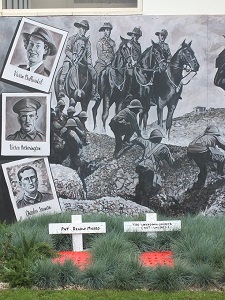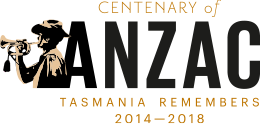Sheffield mural depicts Centenary of ANZAC

Sheffield is a town famous for its murals, but until recently there was no mural depicting the town’s involvement in military history and the local people who went to war. The opportunity to apply for a grant changed all that.
The Sheffield RSL Sub Branch’s Anzac Centenary Project Committee successfully applied for a grant from the Australian Government Anzac Centenary Local Grants Program with the goal to coordinate a project for the creation of a Centenary of ANZAC mural and garden.
The Chairman of Sheffield RSL Sub Branch’s Anzac Centenary Project Committee, Ian Porter, said artist Damian Rossiter of Burnie was selected to paint the mural as his work was known through Sheffield’s International Mural Fest; and horticulturist Robert Gower was chosen to create a garden to complement the artwork.
Capturing 100 years of military history
The mural is a depiction of the Centenary of ANZAC and captures 100 years of military history in an artwork that is 10.5 metres long and 2.4 metres high.
“The main image is like a timeline starting with World War One with mounted horsemen, then depictions of other conflicts and moving through to modern times to Desert Storm and soldiers serving in Afghanistan,” Damian said.
Damian also said he enjoyed painting the mural and working with people and history.
“My great-granddad was a mounted rifleman from New Zealand. My nan gave me some of his military items to hold onto while doing the mural. My nan was pretty emotional when she saw the mounted riflemen on the mural.”
Mural remembers local service people
 The
only stipulation the Anzac Centenary Project Committee placed on the mural design
was that it had to feature six local people or war service people who had
served at Gallipoli and in World War Two. Damian was presented with photos of
ex-service personnel and asked to select who would appear in the mural. The six people selected include
representatives from the Army, Navy and Air Force:
The
only stipulation the Anzac Centenary Project Committee placed on the mural design
was that it had to feature six local people or war service people who had
served at Gallipoli and in World War Two. Damian was presented with photos of
ex-service personnel and asked to select who would appear in the mural. The six people selected include
representatives from the Army, Navy and Air Force:
- Vivian Bullwinkel, of South Australia was the only survivor of the Banka Island massacre in 1942. She is the only non-Tasmanian resident featured on the mural. Damian decided to include her as he was interested in her story.
- Victor Hetherington was born at Claude Road, Sheffield, and was married to Jessie (nee McCoy) when he enlisted on 15 May 1916. He died of wounds on 14 June 1917 and is buried at the Bailleul Communal Cemetery Extension in France.
- Charles Jarman, of Nook, and his brother Maurice both enlisted at Claremont on 8 February 1916. Charles returned to Australia on the Benalla on 10 April 1917 and was discharged on 18 May 1917.
- Maurice Jarman, like his brother of Charles served with the 52nd Battalion. Maurice returned to Australia on the Wiltshire on 31 December 1916 and was discharged 24 February 1917.
- Mary Mahoney was born at Railton on 2 February 1892, trained as a nurse in Launceston and enlisted on 11 December 1916. When she married Major Theodore Pascoe in 1919, she had to leave the nursing corps. The couple returned to Australia on the Delta on 3 September 1919.
- John Braid was born at West Kentish on 9 April 1878 and enlisted at Sheffield on 21 June 1916. The farmer quickly rose to the rank of Sergeant and served with the 40th Battalion. He returned to Australia on 26 June 1919.
Establishing a garden to keep memories alive
When horticulturist Robert Gower was asked to create a garden for the mural, he jumped at the opportunity. Robert is descended from servicemen and values keeping memories and stories alive.
“I saw the garden as a chance to give something back to my father, grandfather, and great-grandfather. It became very personal and whenever I think about it I still get a bit choked up,” said Robert, a direct descendant of the following servicemen:
- Samuel F. Gower (Robert’s great-grandfather), who was on the "HMS Goliath" in the Dardenelles (Gallipoli Peninsula) on13 May 1915 when it was torpedoed and sunk.
- Francis R. Gower (Robert’s grandfather), who landed at Gallipoli on 26 April 1915 and was shot in the left forearm, six inches (15.24 centimetres) from his heart. He was admitted to hospital in Helipolis on1st May 1915.
- Allan D. Gower (Robert’s father), who served in World War Two with the 2/33 Australian Infantry Force.
Robert based the mural’s garden design on the landing at Gallipoli and established the garden so all aspects have meaning:
- The mounds and the Festuca grass represent the lack of plant cover at the landing.
- The red crushed rock represents the mud.
- The retainer walls are the trenches.
- The Banksia ground covers represent the soldiers.
- The Red Cross Rose represents Red Cross.
- Rosemary was planted for remembrance.
“I wanted to make the landscape interactive and connect with the art, and to make it 3D. I also wanted the tourists to be able to interact with the art and the landscape, so they feel part of it,” Robert said.
Robert gave two local school students a concrete slab to paint that would be set in the garden beds. The students were given total freedom to paint what they wanted to represent for the Gallipoli landing. Robert was amazed by the result.
“What the students came up with was so simple but also profound,” he said.

Working from the left to the right, the students presented a footprint that becomes an army boot; a beautiful blue ocean that turns to blood red with ammunition shells; seaweed that becomes barbed wire.
The garden also includes crosses on the gravesites that read: "Private Dearly Missed", and "The Unknown Soldier but not unloved".
“I wanted to put the crosses in the gravesites so people would read and make them think of those who never came back,” Robert said.
The Unveiling
The mural was unveiled on Remembrance Day, 11 November 2014, with some World War Two veterans arriving as guests of honour by horse and carriage.
The Sheffield RSL Sub Branch loves the mural, and the Anzac Centenary Project Committee – which ran trivia nights and a ball to help fund the gardening – are inspired to undertake more projects during the Centenary of ANZAC.
View the official opening of the Sheffield mural.
Find out more about the Sheffield Anzac Centenary Project Committee on Facebook.

